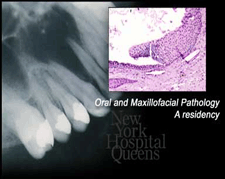المقالات
Periapical Granuloma

A periapical granuloma is a relatively common lesion or growth that develops around the tip of a tooth's root. It consists of a proliferating mass of granulation tissue (new tissue that forms on a wound) and bacteria that forms in response to dead tissue in the pulp chamber of the tooth. The death of the pulp may be due to extensive decay, deep restorations, or trauma to the tooth. The formulation of a periapical granuloma represents the body's attempt to heal and wall off an infection. Normally, periapical granulomas resolve after the source of the infection is removed (following root canal treatment), but residual periapical granulomas may persist even after the offending tooth is extracted unless the tissue is carefully removed at the same time. Periapical granulomas enlarge slowly and can grow to reach several centimeters in diameter. Smaller lesions (a few millimeters in diameter) do not have clearly defined borders and can be difficult to identify. Larger lesions, however, have well-defined borders and are often surrounded by bundles of collagen, a gelatin-like substance, making them identifiable on an x-ray. As the granulomas enlarge, they do not cause the affected area to expand, but they can cause bone loss around the root tips. Unless a secondary infection develops, there are no other symptoms associated with periapical granulomas.
If allowed to progress, periapical granulomas may develop intoradicular cysts. In addition, they can develop a secondary infection which results in an acute or chronic abscess, causing extreme pain. Besides pain, an untreated abscess may result in spreading of the infection into the surrounding soft tissue, the jaw bone, or elsewhere in the body, creating a much more serious situation.
* We will likely need to remove the infected portions of the tooth pulp by performing root canal therapy.
* If we cannot remove the infection with root canal therapy, the affected tooth may need to be extracted (removed).
* We may prescribe antibiotics to fight the infection.
* If you have any discomfort associated with a secondary infection, a warm salt water rinse may provide some relief. Mix one teaspoon of
salt in one cup of warm water, and gently swish and spit.
